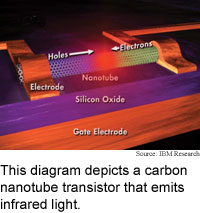
Nanotube shines telecom light
Researchers are continually working to expand
the usefulness of carbon nanotubes -- rolled-up sheets of carbon atoms found
naturally in soot.
Scientists from IBM Research have found a way to make the microscopic
tubes emit light, and have fashioned a nanotube transistor that emits 1.5-micron
infrared light, a wavelength widely used in telecommunications.
Nanotubes can be smaller than one nanometer in diameter, and show
promise as building blocks for fantastically small electronics and machines.
A nanometer is one millionth of a millimeter, or about the length of a line
of 10 hydrogen atoms.
Carbon nanotubes have already been used as wires to carry electricity
and transistors to control electric current. Light-emitting nanotubes could
be used to form efficient communications devices and, eventually, all-optical
computer chips.
The researchers found that if they inject electrons, which carry
negative charges, into one end of a nanotube, and holes, or positive charges,
into the other end, the two combine to emit light whose wavelength is inversely
proportional to the tube's diameter.
It will be about a decade before infrared nanotubes are used in
practical devices, according to the researchers. The work is slated to appear
in the the May 2, 2003 issue of Science.
Screen arcs widen view
Light show makes 3D camera
Net scan finds like-minded users
Sound forms virtual test tubes
News briefs:
Nanotube shines telecom light
Touchy-feely goes remote
Light mix makes strong metal
Metal expands electrically
Researchers fill virus with metal
Gold connectors stretch

Research Watch blog
View from the High Ground Q&A
How It Works
RSS Feeds:
News
Ad links:
Buy an ad link
Ad links: Clear History
Buy an ad link
|
TRN
Newswire and Headline Feeds for Web sites
|
© Copyright Technology Research News, LLC 2000-2010. All rights reserved.